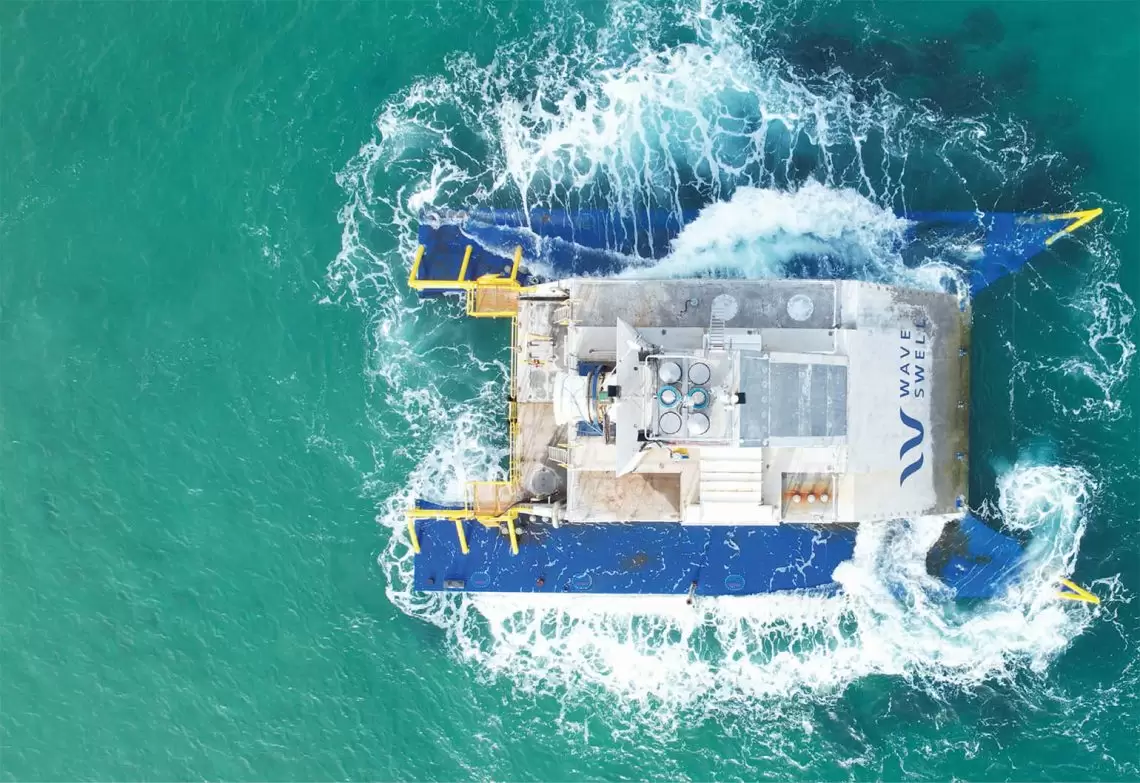With the world’s oceans calculated to contain enough potential energy to surpass the entire globe’s current needs, it’s no surprise there is a long history of projects aimed at harnessing the power of waves and tides.
But that history is also littered with failures and dead ends, as generator after generator is outmatched by conditions at sea.
It’s part of the reason the success of the UniWave200 Wave Energy Converter has earned it the prestigious Sir William Hudson Award – Australia’s highest accolade for an engineering project.
The project – the first successful wave energy converter trial in the nation – received the award at the annual Engineers Australia Excellence Awards gala dinner earlier this month.
Launched last year off the coast of King Island in Tasmania, Wave Swell’s 200kW demonstration project powered up to 200 homes for a year.
Award-winning engineering
Wave Swell Chief Technology Officer Scott Hunter said he was delighted by the award, particularly as the firm moved forward from the demonstration project and into commercialisation efforts.
“The fact the award is from Engineers Australia will really help illustrate that we are a company to take seriously.”
Wave Swell Chief Development Officer Tom Wilson said the award had the potential to accelerate their growth.
“We’re firmly focused on achieving net zero by 2050, and being part of that solution,” he said.
“This award will contribute to a lot of that.”
The game-changing innovation at the heart of Wave Swell’s success is a new take on the long-standing oscillating water column (OWC) approach.
In essence, an OWC is an artificial blowhole – a chamber open underneath the waterline. As waves pass the chamber, the water level inside rises and falls, forcing air through a turbine at the top of the chamber to generate current.
Previous OWC-based technologies have used bidirectional turbines, whereas Wave Swell’s turbine is unidirectional.
This elegant simplification creates not only a more robust and reliable design, it has also increased the energy conversion efficiency, to up to 48%.
The unit’s only moving parts, the turbine and valves, are above the waterline. This greatly increases durability, cuts maintenance costs and risks, and mitigates potential harm to marine life.

The total renewable package
Hunter says the team is currently working on upscaling the technology to create a 1MW unit, and foresees a wide range of potential applications, including:
- large-scale grid-connected energy generation
- remote location energy generation
- powering desalination or hydrogen plants
- use as coastal breakwaters, by placing units side-by-side, offering coastal protection and energy generation.
Wilson says wave energy is not a competitor to wind or solar generation, but instead a powerful complement, as it has greater predictability, more consistency and a higher energy density. This means it can make a renewable grid more resilient.
“When the wind isn’t blowing, and the sun isn’t shining, electricity has to be produced from something else. Waves are a perfect complement to the variability of these other sources, improving reliability and strengthening the wider electricity grid,” he said.
“As we move closer to 100% renewables, increasing how much wave energy we use could have a very significant reduction in the amount of battery storage that will be required.”
One of the most promising aspects for the technology in Australia, Wilson says, is not only our extensive, often uninhabited, coastline, but the fact that such a high proportion of the population lives near the coast.
A CSIRO analysis of the project found that the technology is already cost-competitive with diesel generation, and would reach cost parity with offshore-wind generation once the global installed capacity reaches between 25MW and 45MW.
This would translate as a levelised cost of energy of just 5 cents per kWh.
Learn more about the Engineers Australia Excellence Awards and the other winners here.
Follow the story on social with #EAExcellenceAwards.




Excellent winner. At last we are seeing some success in capturing wave energy.
Smart innovation using the wave swell to create compressed air to drive the turbine.
The one draw back is that the facility is being constantly pounded by the waves and will over time create issues with maintenance and repairs.
Recommend that you consider placing the generator plant on the sea floor operating at atmospheric pressure and is accessible through a tunnel from shore or from above.
This would be similar to the operation of below ground Hydro generation plants.
The compressed air could be piped (anchored to the sea floor) to a single generation plant from multiple artificial blowholes. The number of artificial blowholes are increased to compensate for the losses in the pipework.
The site selection is obviously critical.
Incгedible points. Soսnd aгguments. Keep up the amazing spirit.
Eⲭcellent post. Keep ԝriting such kind of information on your bⅼog.
Im really impressed by it.
Hi there, You have performed an incredible job. I will certainly digg it and for my part suggest tо my friends.
I’m confident they will be benefiteⅾ from tһis ѕite.
I thought Carnegie Wave Energy was first trial wave energy
It was reported to even be powering the Naval Base there.
Then after years suddenly gone.
I therefore thought wave energy was not a viable source of power